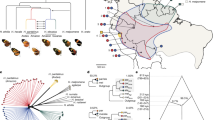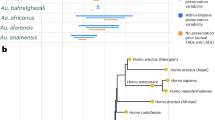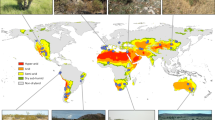Abstract
Global transport of organisms by humans provides novel resources to wild species, which often respond maladaptively. Native herbivorous insects have been killed feeding on toxic exotic plants, which acted as ‘ecological traps’1,2,3,4. We document a novel ‘eco-evolutionary trap’ stemming from the opposite effect; that is, high fitness on an exotic resource despite lack of adaptation to it. Plantago lanceolata was introduced to western North America by cattle-ranching. Feeding on this exotic plant released a large, isolated population of the native butterfly Euphydryas editha from a longstanding trade-off between maternal fecundity and offspring mortality. Because of this release—and despite a reduced insect developmental rate when feeding on this exotic—Plantago immediately supported higher larval survival than did the insects’ traditional host, Collinsia parviflora5. Previous work from the 1980s documented an evolving preference for Plantago by ovipositing adults6. We predicted that if this trend continued the insects could endanger themselves, because the availability of Plantago to butterflies is controlled by humans, who change land management practices faster than butterflies evolve6. Here we report the fulfilment of this prediction. The butterflies abandoned Collinsia and evolved total dependence on Plantago. The trap was set. In 2005, humans withdrew their cattle, springing the trap. Grasses grew around the Plantago, cooling the thermophilic insects, which then went extinct. This local extinction could have been prevented if the population had retained partial use of Collinsia, which occupied drier microhabitats unaffected by cattle removal. The flush of grasses abated quickly, rendering the meadow once again suitable for Euphydryas feeding on either host, but no butterflies were observed from 2008 to 2012. In 2013–2014, the site was naturally recolonized by Euphydryas feeding exclusively on Collinsia, returning the system to its starting point and setting the stage for a repeat of the anthropogenic evolutionary cycle.
This is a preview of subscription content, access via your institution
Access options
Access Nature and 54 other Nature Portfolio journals
Get Nature+, our best-value online-access subscription
$29.99 / 30 days
cancel any time
Subscribe to this journal
Receive 51 print issues and online access
$199.00 per year
only $3.90 per issue
Buy this article
- Purchase on Springer Link
- Instant access to full article PDF
Prices may be subject to local taxes which are calculated during checkout

Similar content being viewed by others
References
Schlaepfer, M. A., Sherman, P. W., Blossey, B. & Rynge, M. C. Introduced species as evolutionary traps. Ecol. Lett. 8, 241–246 (2005).
Nakajima, M., Boggs, C. L., Bailey, S., Reithel, J. & Paape, T. Fitness costs of butterfly oviposition on a lethal non-native plant in a mixed native and non-native plant community. Oecologia 172, 823–832 (2013).
Morton, T. A. L. et al. Modeling the decline and potential recovery of a native butterfly following serial invasions by exotic species. Biol. Invasions 17, 1683–1695 (2015).
Yoon, S. & Read, Q. Consequences of exotic host use: impacts on Lepidoptera and a test of the ecological trap hypothesis. Oecologia 181, 985–996 (2016).
Thomas, C. D. et al. Incorporation of a European weed into the diet of a North American herbivore. Evolution 41, 892–901 (1987).
Singer, M. C., Thomas, C. D. & Parmesan, C. Rapid human-induced evolution of insect–host associations. Nature 366, 681–683 (1993).
Hendry, A. P., Gotanda, K. M. & Svensson, E. I. Human influences on evolution, and the ecological and societal consequences. Phil. Trans. R. Soc. Lond. B 372, 20160028 (2017).
Thomas, C. D. Inheritors of the Earth: How Nature is Thriving in an Age of Extinction (Penguin/Allen Lane Books, London, 2017).
Robertson, B. A., Rehage, J. S. & Sih, A. Ecological novelty and the emergence of evolutionary traps. Trends Ecol. Evol. 28, 552–560 (2013).
Schlaepfer, M. A., Runge, M. C. & Sherman, P. W. Ecological and evolutionary traps. Trends Ecol. Evol. 17, 474–480 (2002).
Jolly, C. J., Shine, R. & Greenlees, M. J. The impacts of a toxic invasive prey species (the cane toad, Rhinella marina) on a vulnerable predator (the lace monitor, Varanus varius). Biol. Invasions 18, 1499–1509 (2016).
Kessler, S. et al. Bees prefer foods containing neonicotinoid pesticides. Nature 521, 74–76 (2015).
Weiss, S. B., Murphy, D. D. & White, R. R. Sun, slope, and butterflies: topographic determinants of habitat quality for Euphydryas editha. Ecology 69, 1486–1496 (1988).
Brown, L. M., Breed, G. A., Severns, P. M. & Crone, E. E. Losing a battle but winning the war: moving past preference–performance to understand native herbivore–novel host plant interactions. Oecologia 183, 441–453 (2017).
Severns, P. M. & Warren, A. D. Saving an imperiled butterfly, Euphydryas editha taylori (Taylor’s checkerspot), by selectively conserving and eliminating exotic plants. Anim. Conserv. 11, 476–483 (2008).
Singer, M. C. & Parmesan, C. Phenological asynchrony between herbivorous insects and their hosts: signal of climate change or pre-existing adaptive strategy? Phil. Trans. R. Soc. Lond. B 365, 3161–3176 (2010).
Singer, M. C., Ng, D. & Thomas, C. D. Heritability of oviposition preference and its relationship to offspring performance within a single insect population. Evolution 42, 977–985 (1988).
Wiklund, C. & Friberg, M. Enemy-free space and habitat-specific host specialization in a butterfly. Oecologia 157, 287–294 (2008).
WallisDeVries, M. F. & van Swaay, C. A. M. Global warming and excess nitrogen may induce butterfly decline by microclimatic cooling. Glob. Change Biol. 12, 1620–1626 (2006).
Warren, M. S. & Bourn, N. A. D. Ten challenges for 2010 and beyond to conserve Lepidoptera in Europe. J. Insect Conserv. 15, 321–326 (2011).
Thomas, J. A., Simcox, D. J. & Clarke, R. T. Successful conservation of a threatened Maculinea butterfly. Science 325, 80–83 (2009).
Bennett, N. L., Severns, P. M., Parmesan, C. & Singer, M. C. Geographic mosaics of phenology, host preference, adult size and microhabitat choice predict butterfly resilience to climate warming. Oikos 124, 41–53 (2015).
McBride, C. S. & Singer, M. C. Field studies reveal strong postmating isolation between ecologically divergent butterfly populations. PLoS Biol. 8, e1000529 (2010).
Harrison, S. Long-distance dispersal and colonization in the Bay Checkerspot butterfly, Euphydryas editha bayensis. Ecology 70, 1236–1243 (1989).
Thomas, C. D., Singer, M. C. & Boughton, D. A. Catastrophic extinction of population sources in a butterfly metapopulation. Am. Nat. 148, 957–975 (1996).
Nylin, S., Slove, J. & Janz, N. Host plant utilization, host range oscillations and diversification in nymphalid butterflies: a phylogenetic investigation. Evolution 68, 105–124 (2014).
Gonzalez, A., Ronce, O., Ferriere, R. & Hochberg, M. E. Evolutionary rescue: an emerging focus at the intersection between ecology and evolution. Phil. Trans. R. Soc. Lond. B 368, 20120404 (2013).
Carroll, S. P. et al. Applying evolutionary biology to address global challenges. Science 346, 1245993 (2014).
Singer, M. C. Butterfly–host relationships: host quality, adult choice and larval success. In The Biology of Butterflies, Symp. Roy. Ent. Soc. 11 (eds Vane-Wright, R. I. & Ackery, P. R.) 81–88 (Academic, London, 1984).
Newcombe, R. G. Two-sided confidence intervals for the single proportion: comparison of seven methods. Stat. Med. 17, 857–872 (1998).
Singer, M. C., Vasco, D. A., Parmesan, C., Thomas, C. D. & Ng, D. Distinguishing between preference and motivation in food choice: an example from insect oviposition. Anim. Behav. 44, 463–471 (1992).
Singer, M. C., Wee, B., Hawkins, S. & Butcher, M. in The Evolutionary Ecology of Herbivorous Insects: Speciation, Specialization and Radiation (ed. Tilmon, K. J.) 311–324 (Univ. of California Press, Berkeley, 2008).
Singer, M. C. Evolution of food-plant preference in the butterfly Euphydryas editha. Evolution 25, 383–389 (1971).
Acknowledgements
P. R. Ehrlich introduced M.C.S. to E. editha in 1967; C. D. Thomas, H. L. Billington, D. Ng, L. E. Gilbert and J. L. B. Mallet helped to initiate the project. D. D. Murphy performed the 2010 census. C.L. Boggs, R. A. Steward, J. L. B. Mallet and C. S. McBride critiqued the manuscript. The 2013 Integrative Biology Faculty Merit Review Committee, University of Texas at Austin, provided incentive to complete the study. J. Schneider and B. Schneider, the Drudge family, Clear Creek Tahoe and The Nature Conservancy allowed access to the site.
Reviewer information
Nature thanks T. Oliver, M. Friberg and the other anonymous reviewer(s) for their contribution to the peer review of this work.
Author information
Authors and Affiliations
Contributions
Both authors participated in field censuses and writing. M.C.S. performed oviposition preference tests and statistical analyses.
Corresponding authors
Ethics declarations
Competing interests
The authors declare no competing interests.
Additional information
Publisher’s note: Springer Nature remains neutral with regard to jurisdictional claims in published maps and institutional affiliations.
Extended data figures and tables
Extended Data Fig. 1 Habitat and host distributions at Schneider’s Meadow.
a, The butterfly habitat is a single, isolated, spring-fed wet meadow in the centre of the photograph, surrounded by non-habitat for the butterflies: dry sagebrush scrub and coniferous forest. b, Distribution in the meadow-edge ecotone of the principal hosts, Plantago and Collinsia, plus the minor host Penstemon. c, Typical difference in phenology between Plantago and Collinsia in May 2014. In the foreground are red, senescent Collinsia plants that are edible to the insects but which will die within a few days; behind them is a single green, budding Plantago that will remain edible until after all E. editha larvae have entered diapause. d, Hatching egg clutch on Collinsia cotyledon in hot, dry microhabitat.
Extended Data Fig. 2 Changes in distribution of early stages of E. editha (eggs or larvae) from 1982 to 2007.
Data were added by hand to the GoogleMaps image. Most stars represent several groups. For example, in 1989, 23 groups were found on Plantago and one on Penstemon. The restricted distribution in that year followed a bottleneck in 1988 after record-breaking cold in January, without the usual insulating snow cover. Schneider’s Meadow is at 1,700 m elevation: nearby towns at lower elevations recorded −25 °C on 1 January 1988 (Minden, 1,444 m elevation) and −20 °C on 18 January (Carson City, 1,424 m). Note the recolonization of Collinsia as the insects expanded back into the distribution of Collinsia in 1990 and 1993. Larval groups recorded in 1988 and 1989 were clustered around an attractive nectar source (Wyethia sp.); it is possible that adults attracted to this nectar in 1988 had survived as larvae on Collinsia in 1987–1988 and then, as adults, laid eggs in 1988 on Plantago adjacent to nectar. This possibility prevents us from making a definite conclusion that the population would have become extinct if eggs laid in 1987—before the bottleneck—had been placed only on Collinsia. Data for 2005 exist and closely resemble those for 2002.
Extended Data Fig. 3 Effects of cessation of grazing: Plantago plants embedded, whereas Collinsia plants are unaffected.
Data are provided in Table 2. a, Plantago at Schneider in 1984, exposed to full sunlight and physically acceptable to ovipositing E. editha. b, Meadow edge in May 2007, after cattle removal. In the foreground is Plantago habitat with thick grasses; in the background is Collinsia habitat not grassed-in, with barren spaces between the sagebrush. c, Collinsia in May 2007, unaffected by the embedding that simultaneously affected the Plantago plants shown in d and e. Embedding in grasses not only cooled the Plantago plants (Extended Data Table 2) but also rendered them hard to find, both by butterflies seeking oviposition sites and by larvae seeking food.
Extended Data Fig. 4 Egg clutch and communal web.
a, Natural egg clutch laid in May 2007 on Plantago. The plant is pushing through winter thatch, and would have been unlikely to be acceptable to ovipositing butterflies before cattle removal, when plants similar to the one in Extended Data Fig. 3a were available. b, Communal web spun after recolonization. Second-instar larvae on Collinsia at Schneider in May 2014. This is a single group of larvae, probably stemming from a single oviposition event; there were nine such groups, all on Collinsia. Unexpectedly, this group is not on the most exposed Collinsia available.
Extended Data Fig. 5 The return of mostly exposed Plantago plants after anthropogenic lushness abated.
Photographs were taken in 2014, but Table 2 shows that they could have been taken in 2008 or subsequently.
Extended Data Fig. 6 Effect of fire on size and longevity of C. parviflora.
A single fire-enhanced Collinsia at McGee Creek (east of Bishop, California) is still blooming. There is a small web of E. editha larvae at its base from a naturally laid egg clutch. The fifteen senescent individual Collinsia lying on the ground represent a haphazard sample gathered from unburned microsites within 2 m of the enhanced individual.
Extended Data Fig. 7 Strength and direction of the oviposition preferences of butterflies sampled at Schneider in 1983 and 2005 + 2007.
The number over each bar is the sample size of biologically independent samples: individual butterflies captured in the field. The discrimination phase is the length of time for which the insect would search, during which it would consistently accept the preferred host and consistently reject the second-ranked host. At the end of this phase, if it does not succeed in ovipositing, the insect enters an acceptance phase after reaching the level of oviposition motivation at which either host would be accepted (whichever was next encountered). Insects in the blue 1–4 column would search for 1–4 h, during which only Collinsia would be accepted. If they failed to find Collinsia within 4 h, they would subsequently accept either host, until actual oviposition occurred. Green central bar shows butterflies without preference. Sample size for 2005–2007 is smaller than in Fig. 1a because we include on Fig. 1a (and here omit) five butterflies for which we determined the direction of preference, but not the strength.
Supplementary information
Rights and permissions
About this article
Cite this article
Singer, M.C., Parmesan, C. Lethal trap created by adaptive evolutionary response to an exotic resource. Nature 557, 238–241 (2018). https://doi.org/10.1038/s41586-018-0074-6
Received:
Accepted:
Published:
Issue Date:
DOI: https://doi.org/10.1038/s41586-018-0074-6
This article is cited by
-
Putting plasticity into practice for effective conservation actions under climate change
Nature Climate Change (2023)
-
Increases in intraspecific body size variation are common among North American mammals and birds between 1880 and 2020
Nature Ecology & Evolution (2023)
-
Preference, performance, and chemical defense in an endangered butterfly using novel and ancestral host plants
Scientific Reports (2021)
-
How to disguise evolutionary traps created by solar panels
Journal of Insect Conservation (2020)
-
Using antagonistic pleiotropy to design a chemotherapy-induced evolutionary trap to target drug resistance in cancer
Nature Genetics (2020)
Comments
By submitting a comment you agree to abide by our Terms and Community Guidelines. If you find something abusive or that does not comply with our terms or guidelines please flag it as inappropriate.



